|
Examining Nanoscience
discipline file at www.northcarolina.edu : |
 |
 |
|
1. The
discipline file contained no UNCG
Notification to plan a master’s in
Nanoscience,
2. The
discipline file contained an unsigned “Revised
UNCG Request to Establish a Master’s
in Nanoscience,
3. The
discipline file contained no UNCG
Request to plan a PhD in Nanoscience
4. The
discipline file contained no UNCG
Request to Established a PhD in
Nanoscience |
|
|
Early in the investigation of lack of supporting
documentation for UNCG Nanoscience degree
authorizations Dr. James Sadler Associate Vice
President for Academic Planning University of
North Carolina put forth a chronology of
authorizations (e-mail (08/04/2010). |
| |
May 11, 2007
Board of Governors authorizes establishment of
the Joint School of Nanoscience and
Nanoengineering. You
ask about any request to amend the Joint School,
but I am not aware of any request, emphasis
added. |
| |
|
Dr. Sadler Chronology acknowledged unsigned alleged
“Revised UNCG Request to Establish a Master’s in
Nanoscience dated Nov. 9, 2009 was JSNN Dean
Jim Ryan; |
|
| |
|
From: James C. Sadler < >
Date: Sun, Oct 11, 2009 at 10:07 AM
Subject: Re: Revised version of the Request to Establish the
Professional Master of Science in Nanoscience degree program
To: James Ryan <j>
Cc: dhprrin@uncg.edu,
James C Petersen JCPETERS < >, altont@ncat.edu, kmurray@ncat.edu
Thanks, Jim. I'll confer with Alan about the Ph.D. and
whether anything is needed. Jim Sadler
James Ryan wrote:
Jim,
I have attached a revised version of the Request to
Establish for the Professional Master of Science in
Nanoscience. I have included the most recent update of the
JSNN Management Agreement as well as revised figures on
enrollment. I have also provided additional explanation to
address questions that were asked during the disciplinary
committee review on Wednesday. Please review and let me know
if additional information or clarification is needed.
Also, similar revisions are needed for the Request to
Establish the Ph.D. in Nanoscience. Should I send the latest
version of that document to you as well? Thank you.
Jim
James C. Sadler, Ph.D. Associate Vice
President, Academic Planning
Interim Assoc. VP, Institutional Research & Analysis UNC
General Administration |
|
|
May 2007 UNC Board
of Governors
established alleged
Joint School of
Nanoscience and
Nanoengineering, at
bogus NC A&T / UNCG
Joint Millennial
Campus, UNCG
Affiliate Gateway
University Research
Park, to offer (a)
joint
interdisciplinary
Ph.D. degree and (a)
joint professional
science master's
degree. |
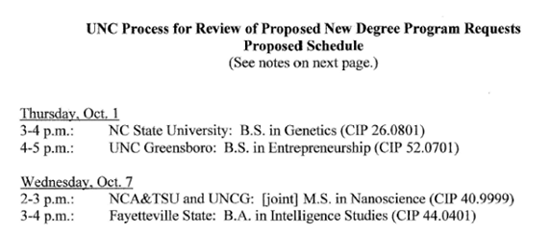 |
|
Memorandum to Chief
Academic Officers
from Alan Mabe and
Jim Sadler, Subject
Restating the
Academic program
Planning and
Evaluation Process
dated September 21,
2009 proposed
schedule for
Wednesday, Oct. 7,
2009 included entry
NCA&TSU and UNCG
[joint] M.S. in
Nanoscience CIP
40.999). |
| |
 |
| |
|
|
Alan Mabe Memorandum dated
March 18, 2010 to Members,
Committee on Educational
Planning, Policies and
Programs, etc Subject
Progress in Reviewing Degree
Proposals indicated UNCG:
[joint JSNN] M. S. in
Nanoscience approved by BOG
Nov. 2009], adding JSNN to
the degree and excluding
NCA&T. |
|
| |
|
January 8, 2010
UNC Board of Governors authorizes the UNCG PhD in
Nanoscience based on the revised request submitted.
The summary that went to the Board can be viewed in
the Planning Committee pre-meeting materials at this
location: https://www.northcarolina.edu/bog/index.php. |
|
|
|
 |
 With
Harold Martin as Chancellor of NC A&T, Erskine
Bowles President of UNC system ,and Alan Mabe Vice
President of Academic Affairs , complicity with
the BOG Planning Committee used the authority to
make recommendation to the BOG to award UNC
Greensboro Nanoscience degrees in conjunction
with the Joint School of Nanoscience and
Engineering excluding NC A&T. With
Harold Martin as Chancellor of NC A&T, Erskine
Bowles President of UNC system ,and Alan Mabe Vice
President of Academic Affairs , complicity with
the BOG Planning Committee used the authority to
make recommendation to the BOG to award UNC
Greensboro Nanoscience degrees in conjunction
with the Joint School of Nanoscience and
Engineering excluding NC A&T. |
 |
 |
| |
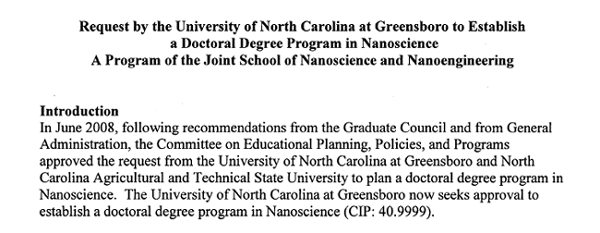 |
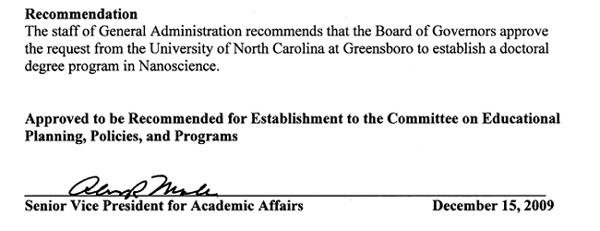 |
|
|
 |
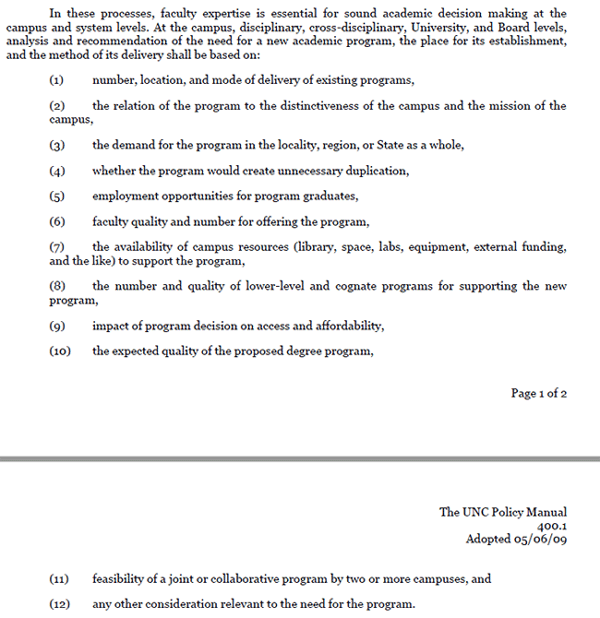 |
|
|
|
The National Center for Educational Statistics
(NCES) responsible for collecting and presenting
statistical data and information for the nation;
classifies Nanoscience and Nanoengineering as
Nanotechnology CIP 15.1601: Engineering
technologies and Engineering related fields. |
 |
|
PCG/UNC-NCCCS/UNC
Interim report
3.doc/RB.SP.PC.CR.ATPCC.1/CC.14/10May05 |
|
|
|
Historical black North Carolina
A&T, as one of the state's two
land grant institutions, has
programs through the doctoral
level. Its programs include
engineering, arts and sciences,
agricultural and environmental
sciences, business and
economics, education, nursing,
technology, and graduates
studies. “The expected roles of
a land-grant institution, is
teaching agriculture and
engineering, and providing
cooperative extension services”
. |
 |
|
|
For Liberal Arts UNC Greensboro with doctorial
programs in music and nursing to offer
Nanoscience degrees requires access to NC A&T
academic programs and research: “Although the
degree is in Nanoscience (does not include
Nanoengineering),

students will be given the opportunity to take
relevant courses at the School
of Engineering at North Carolina A&T University
and must be able to work on collaborative
projects with faculty in the School of
Engineering. |
|
|
|
Unlike land grant cross-town historical Black
NCA&T with strong programs in engineering
offering Nanoscience constituted a Substantive
Change as defined by SACS from previous approved
circular at historical white women UNCG with
strong programs in liberal Arts. (UNCG)
Rebecca Adams to (SACS) Tom Benberg: Sarah
Armstrong Subject: Request for interpretation of
accuracy of nanoscience message, April 13, 2010:
The bottom line, however, is that we need to
submit a full prospectus and need to do so as
soon as possible. This request will be for
approval to initiate a new off-campus site
(South Campus) and to initiate a new degree
program (MS in Nanoscience) at that site. Contrary
to previous interpretations, both represent
substantive changes.. Due to the confusion,
they are willing to waive the requirement that
we do so 6 months in advance and will usher it
though the approval process in a timely way so
that we can accept students into UNCG's MS in
Nanoscience program next fall. |
|
|
|
”The addition of a doctoral
program is not an easy or
simple extension of the
master’s program. Unlike
most master’s programs, a
doctoral program is
research-based. While
doctoral program
requirements routinely
include additional course
work, the central program
requirement is the
dissertation. The topic for
the dissertation normally
derives from discussion with
faculty who are engaged in
research and therefore
knowledgeable about the
“frontier of knowledge” in
the discipline. For a
faculty member to then
properly guide and assist
the student’s dissertation
research, that faculty
member must be an active
researcher. Hence, the
implementation of a doctoral
program must be preceded by
the assembling of faculty
who are conducting
publishable research in that
discipline. UNIVERSITY
OF NORTH CAROLINA PROGRAM
DUPLICATION STUDY Submitted
by James H. Woodward
November 1, 2011 p12] |
|
|
NCA&T was 4th in Funding
in Nanotechnology Research at North
Carolina Universities with $11 Million
Dollars between 2000-2005. UNC at
Greensboro 10th among the 11
institutions conducted $45,000 dollars
of Nanotechnology research between 2000
thru 2005. |
Nanotechnology is Experimental
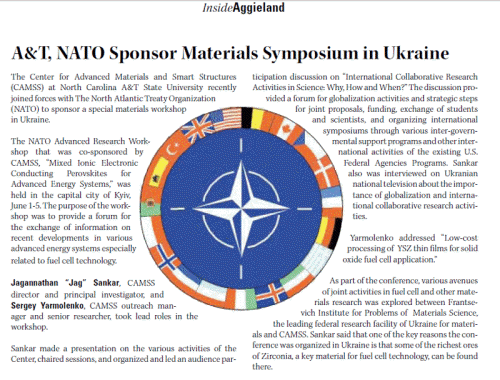 NCA&T
State University has been funded
at an average rate of $3-5
million per year in the area of
nanoscience and nanotechnology.
Most of the research in
nanoengineering is done in the
Center for Advanced Materials
and Smart Structures (CAMSS).
Several Centers and projects are
under CAMSS, including the NSF
Center for Research Excellence
in Science and Technology
(CREST), the DoD Center for
Nanoscience, Nanomaterials and
Multifunctional Materials (CNN)
for Homeland Security, the NSF
Nanoscale Science and
Engineering Center (NSEC), the
NSF project on US/Europe
Materials Collaboration:
Self-Organized Nanostructured
Thin Films for Catalysis, the
NSF project on Nanoscale
Interdisciplinary Research Teams
(NIRT), the NSF Major Research
Instrumentation for
Nanoengineering Research, and
the NSF Nanotechnology
Undergraduate Education (NUE)
program. CAMSS also facilitates
many of the materials research
activities of the NASA-National
Institute for Aerospace (NIA).
In addition, the Center for
Composite Materials Research (CCMR)
does research in nano-enhanced
composite materials and the Army
Center of Excellence for
Battlefield Capability
Enhancements (Flexible Displays)
does research in material
characterization and development
of novel displays. NCA&T
State University has been funded
at an average rate of $3-5
million per year in the area of
nanoscience and nanotechnology.
Most of the research in
nanoengineering is done in the
Center for Advanced Materials
and Smart Structures (CAMSS).
Several Centers and projects are
under CAMSS, including the NSF
Center for Research Excellence
in Science and Technology
(CREST), the DoD Center for
Nanoscience, Nanomaterials and
Multifunctional Materials (CNN)
for Homeland Security, the NSF
Nanoscale Science and
Engineering Center (NSEC), the
NSF project on US/Europe
Materials Collaboration:
Self-Organized Nanostructured
Thin Films for Catalysis, the
NSF project on Nanoscale
Interdisciplinary Research Teams
(NIRT), the NSF Major Research
Instrumentation for
Nanoengineering Research, and
the NSF Nanotechnology
Undergraduate Education (NUE)
program. CAMSS also facilitates
many of the materials research
activities of the NASA-National
Institute for Aerospace (NIA).
In addition, the Center for
Composite Materials Research (CCMR)
does research in nano-enhanced
composite materials and the Army
Center of Excellence for
Battlefield Capability
Enhancements (Flexible Displays)
does research in material
characterization and development
of novel displays. |
|
|
|
|
|
Unambiguous North Carolina A&T State
University was the better host base on : (1)
number, location, and mode of delivery of
existing programs,
(2) the relation of the program to the
distinctiveness of the campus and the mission of
the campus,
(3) the demand for the program in the locality,
region, or State as a whole,
(4) whether the program would create unnecessary
duplication,
(5) employment opportunities for program
graduates,
(6) faculty quality and number for offering the
program,
(7) the availability of campus resources
(library, space, labs, equipment, external
funding, and the like) to support the program,
(8) the number and quality of lower-level and
cognate programs for supporting the new program,
(9) impact of program decision on access and
affordability,
(10) the expected quality of the proposed degree
program, |
|
|
| JSNN
Nanoscience/Nanoengineering degrees cost
State $660,000 per degree |
|
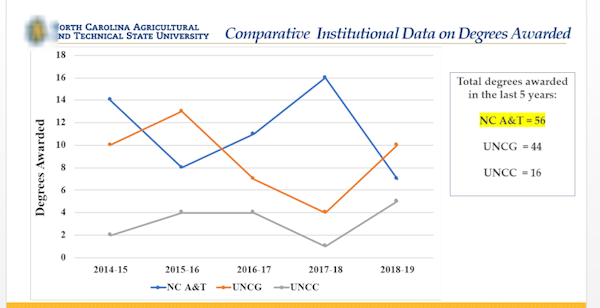 |
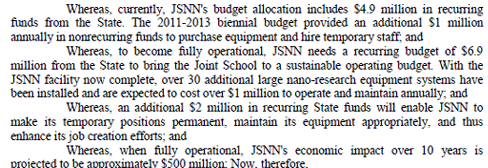 NCA&T
academic programs, instructors, and
research had to support the 44 UNC
Greensboro Nanoscience degrees. Unambiguous
UNC Board of Governors and UNC General
Administration exploited HBCU NC A&T
Engineering circular and research to
establish Nanoscience MS and Ph.D. at
cross-town white UNC Greensboro. NCA&T
academic programs, instructors, and
research had to support the 44 UNC
Greensboro Nanoscience degrees. Unambiguous
UNC Board of Governors and UNC General
Administration exploited HBCU NC A&T
Engineering circular and research to
establish Nanoscience MS and Ph.D. at
cross-town white UNC Greensboro. |
Beginning in 2012-2013 thru 2020-2021
the UNCG/NCA&T
Nanoscience/Nanoengineering fund
continuing budget has been 6.9 Million
Dollars per year costing 55.2 million
dollars, plus
an additional $10.8 million dollars for
prior years for a total of $66 million
dollars. The Programs produced 100
Nanoscience/Nanoengineering degrees at
cost of $660,000 per degree.
producing 100 degrees costing. See (SB862/HB 257:UNCG/NCA&T
Nanoscience/Nanoengineering Funds.) |
|
|
|
When all of the occupations which will be
affected by nanotechnology will require a BS in
engineering with a broad, interdisciplinary and
multi-disciplinary approach; will require an
understanding not only of electrical, mechanical
and civil engineering, but biology, physics and
chemistry as well.

Why is
across-town Liberal Art UNC Greensboro with
programs in music and nursing, requiring
relevant courses be taken at the School of
Engineering at North Carolina A&T University and
will be able to work on collaborative projects
with faculty in the School of Engineering”, except
for unvarnished racism offering Nanotechnology
degrees |
|
|
|
{1]Nanobiotechnology Center of Innovation North Carolina
Biotechnology Center 20/11/2007 |
| {2] Jack
Scism TRIAD SCIENTIFIC RESEARCH CENTER:
VIABLE DREAM OR PIE IN THE SKY? , JACK SCISM, Greensboro
News & Record - Monday, July 20, 1992 . (emphasis added |
| [3] Request to
Establish NCA&T/UNCG Joint School of Nanoscience and
Nanoengineering March 5, 2007 |
| [4] (Jonnelle
Davis (Nano, money No.1 on A&T, UNC-G list News & Record
10.04.2010) |
| [5] UNC-G, A&T to seek $65M for nanotech
school, Matt Evans The Business Journal Serving the Greater
Triad Area, Nov 13, 2006 |
| [6] Jonnelle Davis (Nano, money No.1 on
A&T, UNC-G list News & Record 10.04.2010 |
| [7] [Ken
Mayer, Editorial, UNCG, A&T University will need to be
leaders in the charge for high-tech industry in the Triad,
Triad Business Journal Nov 9, 1998] ( Ken Mayer is former
Chairman UNCG BOT 2003-2004 & 2004-2005 |
| |
| [9] UNCG
and NC A&T partner to create joint program in
nanotechnology, Sharlini Sankaran, October 8, 2007, North
Carolina Board of Science and Technology, http://www.ncnanotechnology.com/public/features/UNCG-NCAT.asp |
| [10] ]
High Research Activity The Scientist http://www.the-scientist.com/2007/03/01/s31/1/ |
| [11] |
| 12 [PCG/UNC-NCCS/UNC
Interim report3. doc/RB.SP.PC.CR.Atpcc.I /CC.14/10May05 page
109] |
|




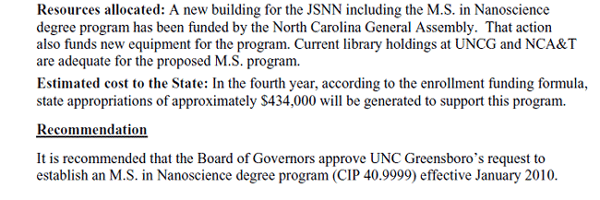

















 NCA&T
academic programs, instructors, and
research had to support the 44 UNC
Greensboro Nanoscience degrees.
NCA&T
academic programs, instructors, and
research had to support the 44 UNC
Greensboro Nanoscience degrees. 